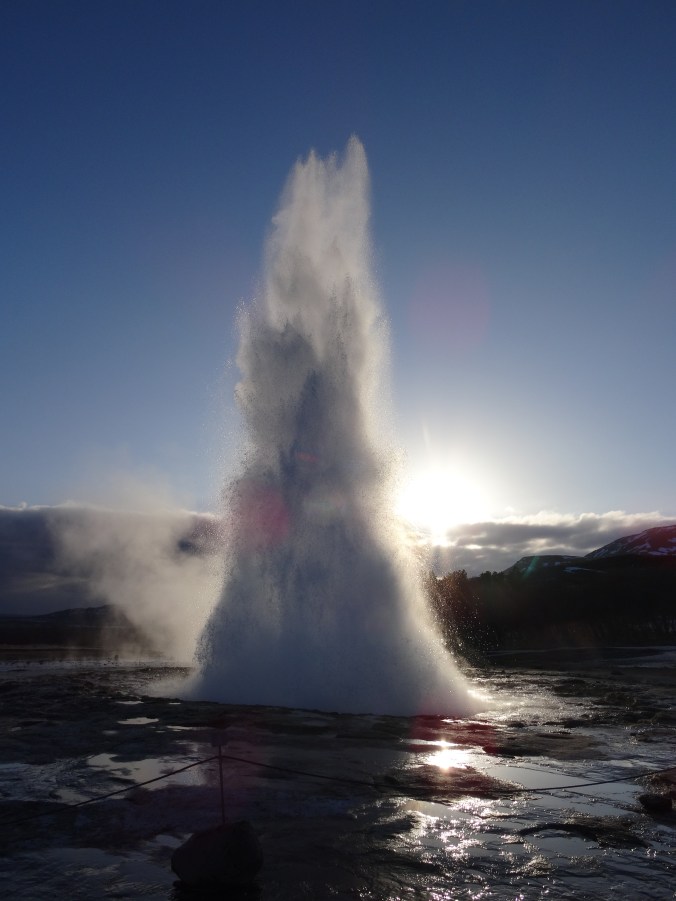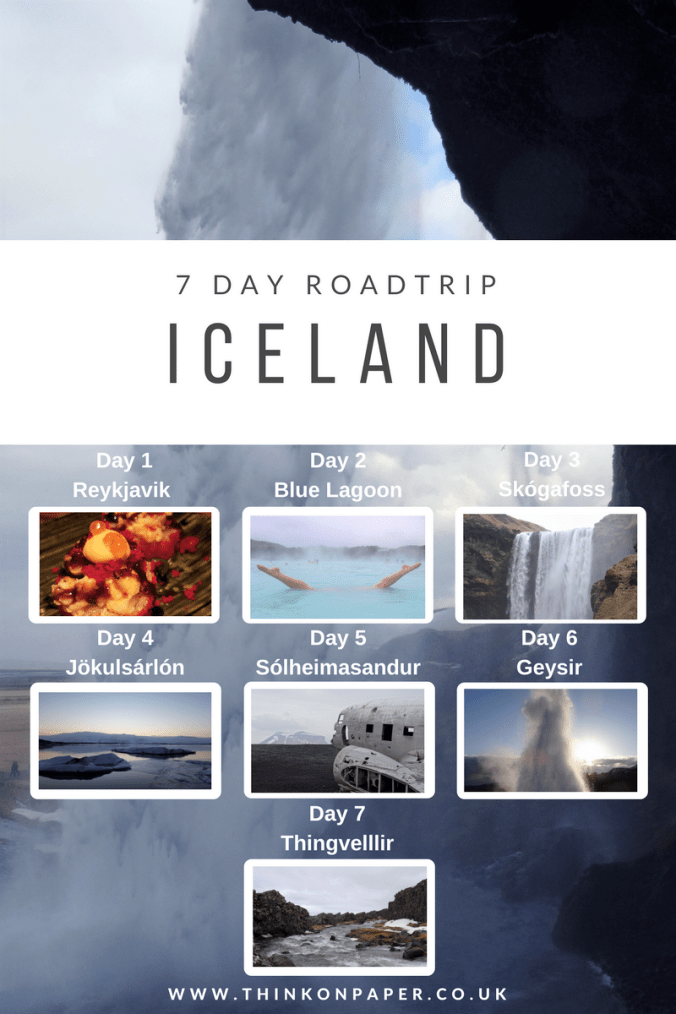Iceland road trip
Iceland. A place that needs no introduction, it has become a travel favourite in recent years and it seems like you can’t open Instagram without a stunning Iceland shot somewhere in your feed. Despite this, when you first start researching it you think there can’t be that much to see, that a lot of it might be a barren and unpopulated with a few cool sights and things to do along the way.
In March 2016 I spent a week driving around Iceland’s West and South coast, hitting the major sights including the Blue Lagoon, Golden Circle and Jökulsárlón glacier lagoon. Here you can read about what I got up to, see the routes I drove and see my itinerary to use for your own trip. The full itinerary is below, you can also download your own pdf here: Iceland pdf itinerary

One week Iceland itinerary
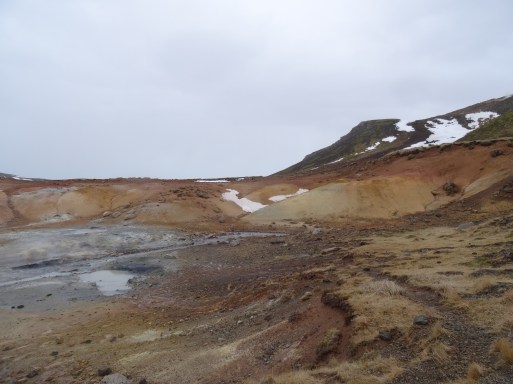
Bleak but beautiful, colourful rock formations in Gunnuhver geothermal area
But once you start researching Iceland, you quickly realise that there’s enough to see and do to fill a whole month of travel and it’s hard to know where to start. For one thing, Iceland is almost two different countries; Iceland in the winter and Iceland in the summer. So, the first thing you need to decide is what time of year you want to go.
There are lots of things you can see and do in the winter (visiting ice caves, for example) that you can’t do in summer, and conversely Iceland’s beautiful interior is impassable in winter, so you need a summer trip if you don’t want to be confined to the coast.
Having never ventured much further north than Scotland, I was fixated on the Northern Lights, so my trip was shaped around looking for the right conditions. My research uncovered March as a good time of year to see the Northern Lights as the country is emerging from the snowy skies of winter but not yet nearing the 21 hours of daylight it enjoys in midsummer.

When you’re welcomed by this slightly eerie landscape!
I had originally intended to put together an overview blog post with the whole trip condensed neatly into a thousand words or so, but as soon as I went back through my camera roll from my time there it was clear that was a pipedream. So in order to fit in all my best pictures, it looks like it’ll be spread over quite a few posts!
Day 1: Reykjavik
We arrived at Gatwick to the news that an Atlantic storm was causing havoc for planes in Keflavik and we would be delayed several hours. Still in the UK and afternoon Blue Lagoon plans already scuppered. Everyone tells you to visit when you first arrive or before you leave due to its proximity to the airport (about a 20 minute drive). Luckily they were very accommodating and allowed us to book an afternoon slot for 2 days hence to give us a chance to see Reykjavik and stop by the Lagoon on our way out East.
When we arrived the storm was still blowing a gale and we were temporarily terrified that we had badly misjudged the Icelandic climate as 100mph icy winds tore through us as we struggled to load out luggage into our rental car in a small car park set in a barren moon-like terrain.
We dutifully plugged in the sat nav we had rented and headed for Reykjavik. Driving is pretty east in Iceland, the roads are largely long and straight, there aren’t very many people, and driving seemed pretty safe and disciplined. So don’t ever worry about driving there- renting a car gives you maximum flexibility to stop and start whenever you see some dramatic landscape to photograph (this happens every 15 minutes or so in Iceland).

More amazing landscape in Iceland
Two good driving tips, however, are: don’t bother with a sat nav, get your friend to use their phone and tell you where to go. The functionality is better and someone can just shout left and right at you rather than trying to decipher the 16 letter placement the sat nav has just told you to follow signs for.
Quite aside from the fact that our appreciation of Icelandic was pathetic and we couldn’t understand where it was telling us to go, it didn’t seem wonderfully up to date and Google Maps did an admirable job in its place. Safe your money.
Second, I agonised over whether we needed a 4 x 4. Everything you read will tell you that if you don’t have one you can’t go down this and that road. We never found this a problem. If you were travelling in ‘proper’ winter or were staying much longer and thought you might want to go up some side roads that are 4 x 4 only, then you might want to think more carefully.
But spring / summer driving was absolutely fine and we never felt the urge to go up any 4 x 4 only roads, and the times that we weren’t sure whether we were on one or not, they were well gravelled and it never presented even the smallest problem. A normal car is much cheaper and, depending on when you go, will probably be sufficient.
I lied, I have three driving tips. Take some CDs for the car, or some other way of playing music- your radio isn’t going to work, and when it does, it’ll just be Justin Bieber on a loop.

When your food comes in dry ice. A course on the tasting menu at Fiskmarkaðurinn, Reykjavik
We made it to Reykjavik as night was falling (probably a good thing when you’re still adjusting to left hand drive and spend the journey punching the driver’s side door looking for a gear stick) and waited to be escorted into the apartment we’d rented (Live as Locals Apartments). The place was great, bedroom, bathroom and kitchen / living room. Our host was good enough to walk us into town as she was heading there to meet her friends. We arrived just in time for our dinner reservation.
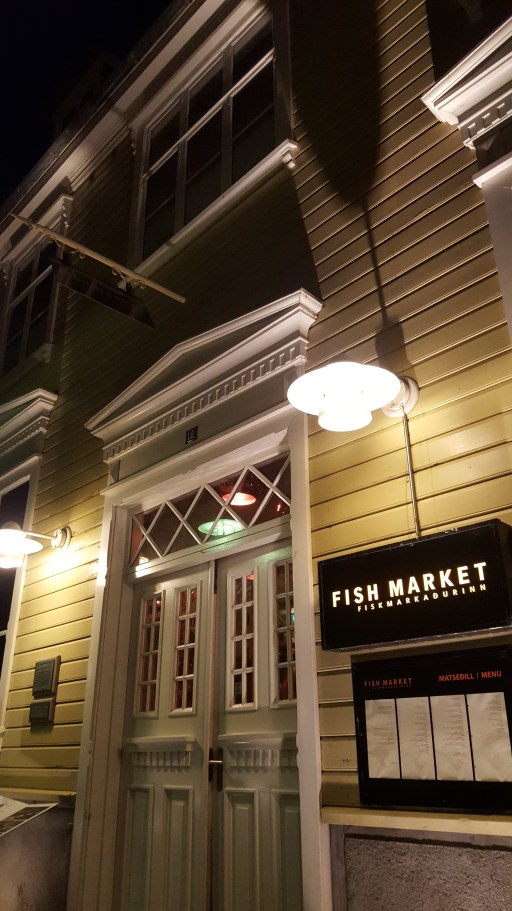
Fiskmarkaðurinn restaurant in Reykjavik
We decided to go all out on the first night and had the tasting menu (with beer pairing!) at Fiskmarkaðurinn. Go here, eat the food, it was amazing. The food looked amazing as well with wonderfully dramatic staging. I don’t remember all of the courses as the beer pairing started to take it’s toll (I woke up to find photos on my phone I don’t remember taking!). They have a sister restaurant, Grillmarkaðurinn, which we didn’t go to, but I’m willing to bet is also very good.
Day 2: a second day in Reykjavik
We finally got a chance to see Reykjavik during the daylight and set about exploring. We headed into town to grab some breakfast and had a look around some of the shops on our way to the Reykjavik Art Museum. We weren’t expecting much, but the museum was great, lots of unusual exhibits in all sorts of different media, including a sandpit you can climb in, building bricks to play with and yet more black sand, this time on top of a light box so you could move it around to make your own art.
The museum is spread over 3 sites, but we only went to Hafnarhús, which is near the harbour and housed in an old harbour warehouse. It was definitely worth a visit- I don’t know a huge amount of contemporary art but always enjoy looking at it for a change, probably because it’s unknown and therefore always very surprising and stimulating.
After this, we did some more wandering around, booked a whale watching tour for the next morning and enjoyed learning about Reykjavik’s history at the Reykjavik 871 settlement exhibition, which also had a display of illuminated manuscripts while we were there.
Day 3: Reykjavik to Skógafoss
This turned out to be an action packed day and our longest on the road. We arrived at the harbour for our whale watching tour to find it was cancelled due to the unsettled weather following the storm that had delayed out plane. They were supposed to have emailed in advance if it was cancelled. Grrrr. So we found ourselves awake and dressed in waterproofs needlessly early with nothing to do on Reykjavik’s harbour.
Reykjanes Peninsula
Our Blue Lagoon slot wasn’t until mid afternoon so we had to find something to entertain us. Luckily we were in Iceland where there’s something amazing around every corner. Since we were packed and ready to go, we decided to leave Reykjavik and explore the Reykjanes Peninsula which surrounds the Blue Lagoon.

Reykjanes lighthouse – Iceland’s oldest lighthouse
Nothing quite prepares you for the sheer diversity of the landscape in Iceland, changing completely every 10 minutes that you drive along, with a waterfall around every corner. I was pretty much speechless all day every day once we were on the road. Sometimes driving is boring, but here the scenery is a hazard of anything, it’s almost a shame I had to concentrate on the road.

The colourful landscape of the Gunnuhavr geothermal area
I had been on fly drive holidays with my parents around the West coast of America as a kid, and the landscape there is unbelievably changeable and dramatic, but it doesn’t change with anything like the frequency of the Icelandic landscape.
We had quickly cobbled together an itinerary for today from the guidebook, which was pretty exciting as we now had a free day to do things we had never planned to see. The route would take us back past the airport, down the West coast of the Reykjanes peninsular to the Gunnuhver geothermal area, up to the Blue Lagoon and then off out East on our planned route to our hotel in Skógafoss.
Our route for the day
Miðlína

Midlina – the rift between the American and Eurasian tectonic plates
First stop was Miðlína, the ‘mid point’ between the American and Eurasian tectonic plates. A kind of black sandy crevasse with a small foot bridge across, it’s not the most exciting of Iceland locations, but it has some beautiful sweeping views out towards the coast. There’s also something wonderfully intriguing about standing between two tectonic plates, especially where you can see such an obvious rift. We spent a bit of time climbing around on the rocks and drawing things in the sand before we had to seek shelter from the still icy wind in the car.

The view to the Reykjanes coast from Midlina
We were off again. The Reykjanes peninsula really does look volcanic, its landscape almost moon-like in appearance, barren and flat. As you travel further south, the black rocky landscape gives way to a still flat, but more colourful area where the geothermal activity has created colourful rock formations as well as more lush, grassy ground.
Gunnuhver Geothermal Area
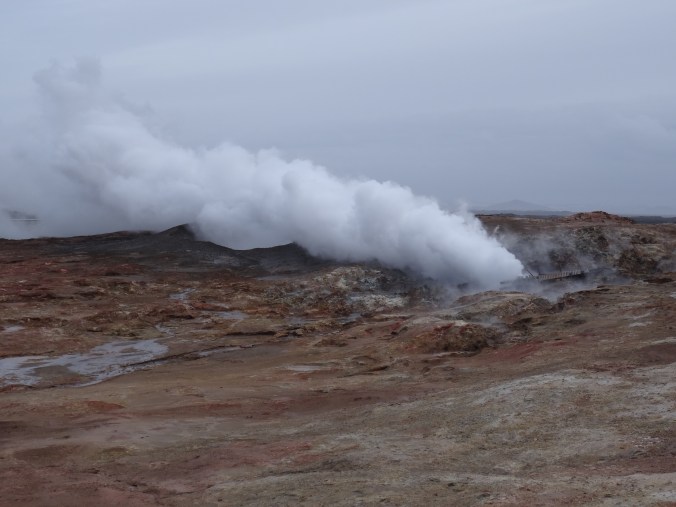
Gunnuhver was more or less deserted and we walked the boardwalks between geothermal attractions mostly alone. Every site is obviously accompanied by the smell of rotten eggs from all the sulphur, and while small, is a dramatic and attractive place to visit full of steam vents and mud pools. The area takes its name from a troublesome ghost who had been laid to rest there after a priest trapped her in a hot spring. That spring is now called Gunna hot spring after the ghost and is the largest mud pool in Iceland.

Broken boardwalks consumed by Gunna hot springs, Gunnuhavr, Iceland
Driving further along the South coast we came to Grindavik, a reasonably large town although spread out and barren like the landscape that surrounds it. We found a charming little place to eat lunch on the harbour in Grindavik, called Bryggjan. We had sandwiches and a delicious lobster soup from a big steaming cauldron. Exactly what you want after a day out sightseeing in the icy winds.
Krýsuvík Geothermal Area

Small lakes at Krýsuvík geothermal area, Reykjanes peninsula, Iceland
With time still to spare before we were due at the Blue Lagoon, we headed off to Krýsuvík Geothermal Area to see more beautiful rock formations and steaming springs. This was even more dramatic than Gunnuhver, including a huge blue pool of striking milky blue water similar to the Blue Lagoon which is opposite the car park to the main mud pools and steam vents of Krýsuvík. The landscape here is really striking, framed by some larger hills in contrast to the much flatter land to the West.

The stunning view from Krýsuvík geothermal area, Reykjanes peninsula, Iceland

Panoramic view Krýsuvík geothermal area, Reykjanes peninsula, Iceland
The Blue Lagoon
Soon it was time to make our way to the Blue Lagoon, one of our major Iceland bucketlist items. The Blue Lagoon really doesn’t disappoint. It’s a very surreal experience to be in bright blue but opaque water, choked with the silica, algae and other minerals. The water itself is apparently white, only appearing blue due to the sun. The water is a mix of seawater and freshwater, originating from 2,000 meters below the surface and emerging into the pool at around 37 – 40 °C (98-104°F).

The whole place is set up for visitors so you can buy towels, food, drink, hair conditioner- everything you need (you definitely need conditioner, by the way) there. It’s not cheap at about £40 for a standard ticket, but you You can also buy spa treatments like massages floating in the Lagoon if you so wish.

Me doing a handstand in the Blue Lagoon!
After spending a couple of hours there it was time to hit the road again. Once night fell it began to pour with rain and we spent the next 3 hours in the car desperately trying to navigate through the dark and driving rain while keeping the car on the road.
I definitely don’t recommend driving in Iceland at night (especially if you’re not used to driving on the right!) as the roads tend to be built up on mounds of earth, meaning after the white line on the outside you have about 6 inches for a margin of error and then you’re in a ditch.
Convinced we should have arrived already (and racing against the clock to make check in before 10pm!) we were relieved to see Seljalandsfoss waterfall illuminated against the night. I knew from my trip planning research that this was before Skógafoss but extremely close (meaning we’d have to drive back to it in the morning). About 20 minutes later we finally pulled into the rocky road leading up to our hotel.
We would not discover until the morning that the huge Skógafoss waterfall was right behind the hotel, and that we in fact had a lovely view of it from our window! After availing briefly of the hotels outside sauna and hot tube to destress from the drive, it was a well earned rest ahead of another action packed day in Iceland.
Day 4: Skógafoss to Skaftafell
Skógafoss
After a massive breakfast at Hotel Skogar (who supplied pickled herring, one of my favourites), it was a short drive up the road to the amazing Skógafoss. As we rounded the corner leading up to it, the sun caught the spray from the falls and lit up a rainbow across the river. The surroundings are beautiful, with a mountainous backdrop and the odd red-roofed farm house breaking up the greenery.

Skógafoss waterfall
We climbed to the top of the fall where you could watch the water pour over the edge to the river below. As our first waterfall sighting in Iceland, it was breathtaking, although they have a tendency to just get more and more spectacular as your journey continues.

The view from the top of Skógafoss waterfall
Seljalandsfoss
After an hour or so enjoying the falls we were back in the car to see Seljalandsfoss, the illuminated waterfall we had passed the night before on our treacherous drive from the Blue Lagoon.

Seljalandsfoss waterfall, Iceland
As one of Iceland’s major attractions, the car park was full of tour buses and other cars, and for once we had to find a parking space, rather than just abandoning the car in an empty lot. After pulling on my waterproof trousers (and realising I had an audience as I performed some serious gymnastics in the driver’s seat to complete the manoeuvre), we hopped out the car to explore.
The waterfall itself is not as high or wide as Skógafoss, but Seljalandsfoss’s USP is that it’s possible to climb behind the falls, providing an amazing
There are plenty of safety notices up and ropes to keep you out as the rocks are icy, wet and slick from the falls and the general weather. We saw more than one person slip and almost end up in the water. Not to be deterred, I followed my much bolder friend over the ropes and gingerly across the rocks which led behind the falls. I was a bit concerned about how we’d get back afterwards, but it was definitely worth the treacherous climb.

Behind Seljalandsfoss waterfall
DC-3 plane crash
Back on the road we carried on to the East, passing Skógafoss where we’d started our day and on to the open road beyond. One of the ‘hidden’ sights on Iceland’s south coast (and I put that in quote marks as it’s made it on to TripAdvisor’s top list of things to do in Iceland, so everyone know it’s there), is a crashed DC-3 plane on Sólheimasandur beach. The US Navy plane crashed in 1974 and the whole crew survived, but the fuselage has never been recovered and now it sits on Sólheimasandur black sand beach.

Crashed DC-3 plane, Sólheimasandur beach
It’s not longer possible to drive out to the beach from the road, so you need to walk the 4km from the road. This excellent blog post gives you the directions to follow the path to the plane wreck, which we successfully found using these instructions. We easily found the turning as there were a number of other cars by the gate. It takes about 45 minutes to walk each way and we were helpfully guided by the stream of people coming back from the plane on the way out- on our way back we aimed for the mountains behind where we’d parked the car.

Fuselage of the crashed DC-3 plane, Sólheimasandur beach
It’s a nice walk over barren black sand and gravel all the way, like a lunar landscape. The plane itself is such a strange sight, perched alone on the black sand. Luckily when we made it everyone else had walked back and we had the site to ourselves to take pictures until we had to turn back to the car.
Dyrhólaey and Reynisfjara
The next stop on the journey was Dyrhólaey to see the coastal rock formations. From up on the cliffs you look down on the waves breaking onto the black sand beach and thrashing against the jagged rocks. Everything is volcanic and formed in the most spectacular shapes.

Volcanic rock formations at Dyrhólaey

Waves on Dyrhólaey’s black sand beach
Reynisfjara beach is another black sand beach, just slightly further around the coast from Dyrhólaey. Towering basalt columns shoot up from the Eastern end of the beach, looking like hundreds of giants’ bar stools. The sun finally made an appearance as we stepped out onto the beach, giving the black rocks a striking blue backdrop.
After enjoying the scenery we were on our way to our stop for the night in Skaftafell in Vatnajökull national park ready to explore the glacier in the morning.

Basalt column formations on Reynisfjara beach

Basalt column formations on Reynisfjara beach
Aurora Borealis
We thought that would be the end of the story for the day, but our obsessive online tracking of the Northern Lights forecast had told us that tonight was our best shot. After a heavy and not so delicious dinner in our hotel (outside of Reykjavik it gets harder and harder to find good food) we headed to bed in our clothes with the alarm set for midnight, ready to pounce on any aurora activity.
When the alarm woke us up we looked eagerly out the window over the mountains of Vatnajökull national park behind our little room. At first we saw nothing, until our eyes adjusted in the darkness and we saw some slowly dancing clouds in the sky in the unmistakable pattern of the Northern Lights.
The lights often appear like white cloud, not like the striking green colours you see in photographs, due to the difficulty our eyes have in detecting colour properly in darkness. We watched them for a while from the window of our room then decided to hit the road in the hope of some clear sky and some stronger lights.
We jumped in the car and hit the road again (me rather more reluctantly than my friend) travelling another 40 minutes East looking for clear sky. At various points in the journey we saw the lights from the car, still the same faint, milky clouds dancing in the sky.
When they suddenly appeared stronger we quickly pulled into a gateway, turned off our lights and jumped out the car. Just as I stepped out, rummaging for my camera, a bright green streak flicked quickly across the sky directly ahead. We had finally seen the ‘proper’ Northern Lights. After sitting in the car for another half an hour to watch the amazing, but much less spectacular white lights, it was finally time for bed, ready to tackle some glacier walking the next day.
Our route for Day 4
Day 5: Skaftafell to Jökulsárlón
Vatnajökull National Park
Vatnajökull National Park is home to Vatnajökull, or Vatna Glacier, Iceland’s largest glacier and one of the biggest in Europe. It covers more than 8% of Iceland. Skaftafell is usually used as a base for those visiting the area, which is exactly what we did.
There are a number of signposted walks around the area which vary in length and difficulty. We opted for one of the more popular sites, Svartifoss waterfall (‘black falls’), a narrow waterfall with a spectacular background of huge black hexagonal basalt columns, which puts you in a mind of a pipe organ.

View from hike to Svartifoss waterfall in Vatnajökull National Park
A number of the hiking routes around the area can be found here. I think we used route S2. We opted for the easier routes as many routes recommend crampons (I think ours did too!) and we only had enough time for 3 hours of walking so we could fit in the rest of that day’s itinerary.
As it was still very early spring and a lot of snow and ice remained on the trail, it probably would have been sensible to have crampons. It was pretty slippy and treacherous in places, especially as it began to slope down towards the waterfall. The uneven and icy ground can make for slow going, so be generous in estimating how long the walks will take you to complete.

Icicles cling to the basalt columns at Svartifoss Waterfall, Iceland
The beginning of the hike was steep but easy, but as the path gave way to icy we slowed considerably, with my friend resorting to the safer but more ridiculous method of sliding down on her butt in places. You get some great views of the rounding landscape and mountains from the top of the climb before descending down towards the river that leads from the waterfall.
Svartifoss waterfall
Svartifoss itself is gradually revealed as you round the last corner on the rocky descent from the hills above. In March it was a wonderful sight, flowing freely but still flanked by a few icicles hanging from the basalt columns. We had apparently arrived the first week it started to get warm (annoyingly meaning our ice cave tour was cancelled due to them starting to melt), which made this hike slightly easier.

Svartifoss waterfall, Vatnajökull National Park
After watching the falls and taking plenty of photos, we crossed the river and headed up the other side for the walk back. This part of the path was less icy but was still a difficult, slow walk due to the mud and uneven ground.

Volcanic rock formations at Svartifoss waterfall, Vatnajökull National Park
Jökulsárlón
Our next stop was Jökulsárlón glacial lake, a fantastical lake at the head of the Breiðamerkurjökull glacier full of large and small icebergs. They float slowly around the lagoon and eventually out to see. Seals love to bask in the sun there, using the pieces of ice as giant lilos.
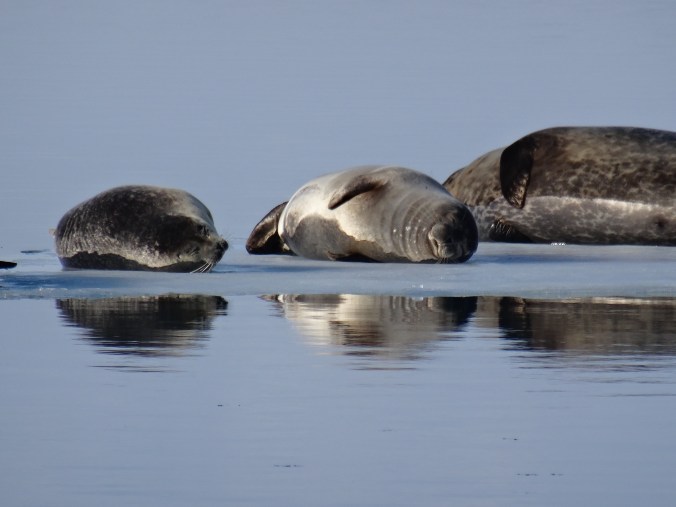
Life is hard in Jökulsárlón glacial lagoon, Vatnajökull National Park
The lagoon was formed when the Breiðamerkurjökull glacier began to melt and retreat from the sea. It covers an area of around 17 square kilometres. Allegedly some of the ice will spend 5 years circling the lagoon before finally making it out to sea.

Luminous blue icebergs floating in Jökulsárlón glacial lagoon, Vatnajökull National Park
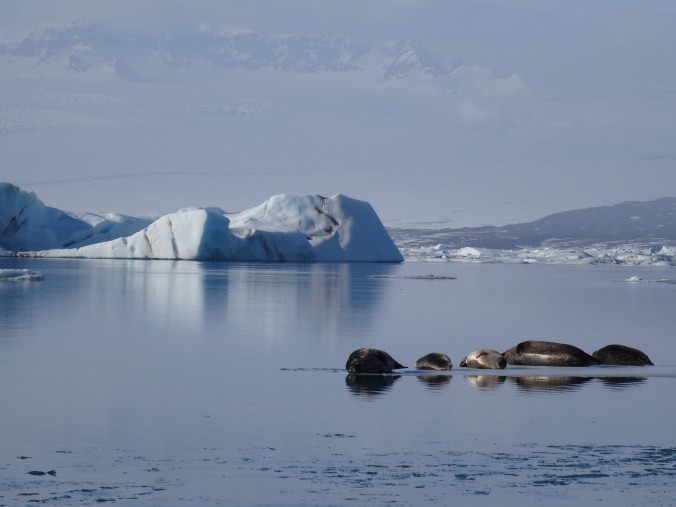
Seals and icebergs in Jökulsárlón glacial lagoon, Vatnajökull National Park
We spent quite some time watching the seals in the lagoon and marvelling at the luminous blue of some of the ice.
Höfn
We hit the open road again for a tour further alone the south coast to the fishing town of Höfn. Mile upon mile of beautiful scenery passed by, from mountains to lakes, waterfalls gushing down the sides of black rocks and the odd farmhouse alone in the countryside.
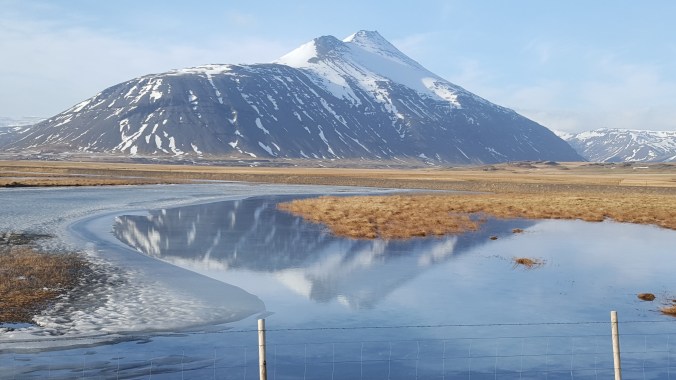
Mountains and lakes seen from Iceland’s Ringroad on the way to Höfn
We didn’t look around Höfn but stayed for a our first good meal since Reykjavik a Kaffi Hornið, where we were greeted by a rather ropey looking stuff fox. The food, however, was excellent- a huge steaming bowl of lobster soup washed down with a reindeer burger.

Sunset behind from the derelict buildings on Iceland’s Ringroad
The sun set as we drove back to our Skaftafell hotel and we popped back into Jökulsárlón to watch the sun dip behind the glacier, watching the icebergs float serenely on the water. This was such a beautiful sight, even more welcome as the weather had been largely overcast during our stay so far. I wholeheartedly recommend that you pop into the lagoon at sunset if you’re in the area at the right time.

Icebergs at dusk in Jökulsárlón glacial lagoon, Vatnajökull National Park
Day 6: Skaftafell to Gullfoss
This was the day we were set to tour the ice caves, but were rescheduled due to the warmer weather starting to melt the ice. Instead the same company, Glacier Guides, booked us on to their morning glacier walking tour, ‘Glacier Wonders’.
Glacier walking on Falljökull
We arrived at their base early on a lovely sunny day to get kitted up with crampons and ice picks. A short bus ride delivered us to the foot of the Falljökull glacier tongue from where it was a short walk until we were on to the glacier proper.
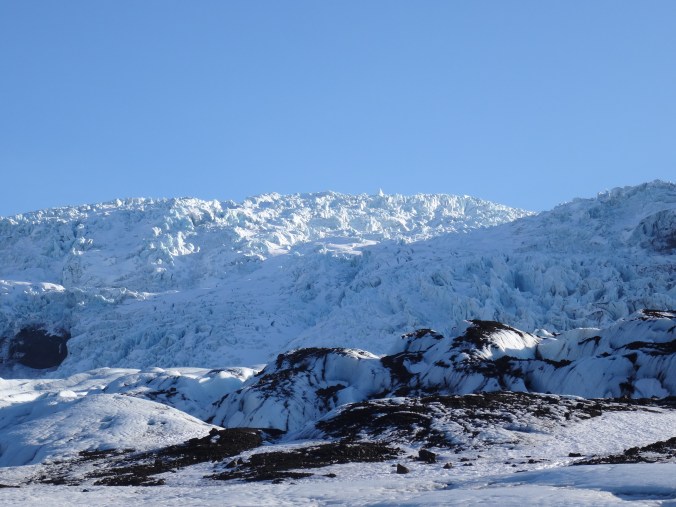
As we stopped at the head of the glacier to put on our crampons, our guide explained the various safety rules for walking on the glacier, including that we must exactly follow his path, where he knew the glacier was safe and would not give way into a crevasse.
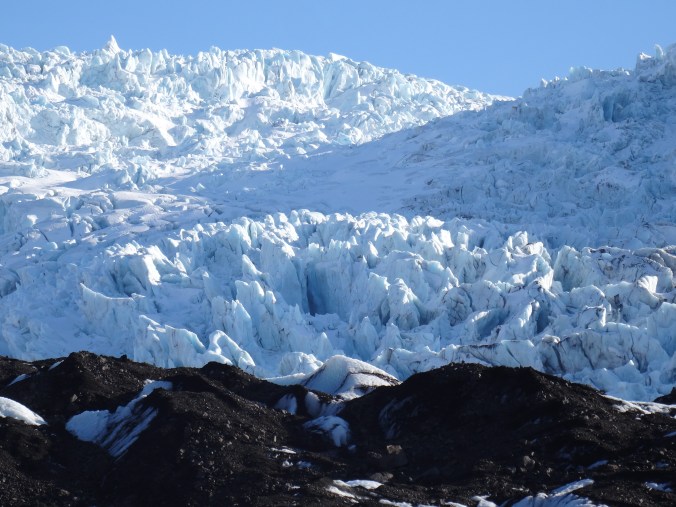
We crept along slightly gingerly knowing the very real dangers lurking on the glacier. Our guide taught us how to walk down the glacier (by digging in your heels and leaning back) and we walked along in the sun enjoying the views. We stopped to see glacier mice- small moss-covered pebbles that travel down the glacier and provide a micro-habitat for tiny organisms.
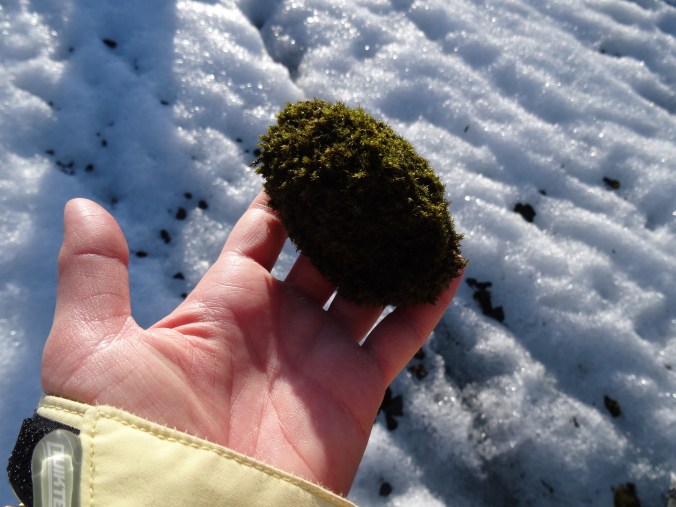
Glacier mouse on Falljökull glacier tongue, Vatnajökull National Park
We also stopped to grab a quick drink of ice cold, super pure water from a glacial stream. A welcome relief from what is actually quite a tiring activity, despite the tour’s ‘easy’ rating! It was a great experience to be walking on a glacier, especially on such a sunny day. We had amazing views across the surrounding landscape from up on the glacier.
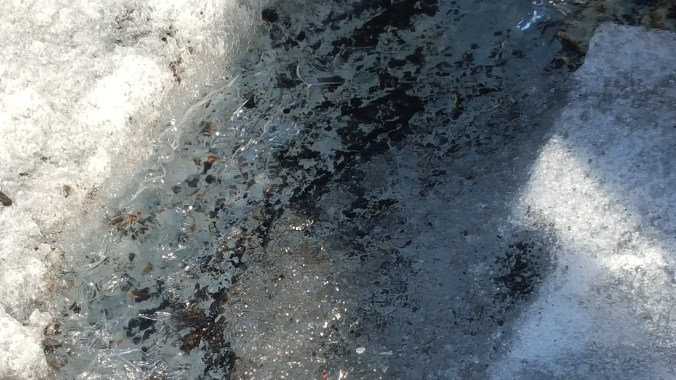
Glacier stream, Falljökull glacier tongue
The end of the glacier walk marked the end of our time in Skaftafell and the South coast- it was time to head back inland to Þingvellir National Park for geysers and yet more waterfalls.

View from Falljökull glacier tongue, Vatnajökull National Park
Geysir and Strokkur
The drive there was as spectacular as always and we got to see much of the landscape we had missed during our dark and wet journey Eastwards to Skogarfoss. On the way to the hotel we stopped at Geysir to see the Great Geysir and Strokkur erupting before the sun set. These geysers are so regular that you can stand for half an hour and see it go off over and over again. As a result, we got some great photos. There’s a café and gift shop opposite which sells some nice local products- it’s quite a good stop for souvenirs of your trip.
